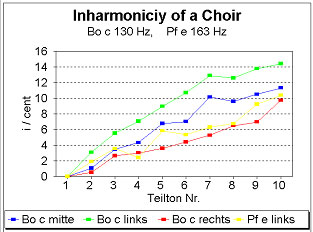[ Lay Language Paper Index | Press Room ]
Is A Grand Piano Always Better Than An Upright Piano?
Klaus Wogram - Klaus.Wogram@ptb.de
PTB-Braunschweig
Braunschweig, Germany
Taro Mori
Tokushima-shi, Japan
Popular version of paper 3aMU5
Presented Wednesday morning, November 12, 2003
146th ASA Meeting, Austin, TX
The question is rather provocative but most piano players answer it with a
clear "yes." If there are real differences between these types of pianos
how can one separate them and make them measurable?
The main properties of pianos with respect to their musical acoustical qualities are:
- the sound (basically its spectra, or range of frequencies),
- the onset and decay time (the sound wave at the beginning and the time
after the piano's hammer strikes the string),
- the inharmonicity of each string (and within a "choir," or group
of strings that form individual notes in grand pianos),
- the directivity of sound radiation,
- the dynamic range (the span between the lowest and the highest playable
sound levels),
- the soundboard's "eigenmode density" (in other words, the number
of soundboard resonances, or preferred vibrations over a given frequency range,
and their frequency values),
- the repetition rate of the action [the maximal possible speed of repeating
one note (key)],
- the efficiency of the dampers for the strings (how effective the dampers
are at preventing a string from oscillating when it is excited by the vibration
of an adjacent string or after the key is released).
These parameters have been investigated in the former laboratory for musical
acoustics at PTB-Braunschweig with the following results:
- Subjective hearing tests with single tones, sequences of single tones,
chords and several musical pieces with recorded sounds at the position of
the players' ears have shown that the sounds of upright and grand pianos can
only be distinguished with sufficient reliability when musical pieces are
played.
Fig. 2 shows the results for single tones (left) and 7 musical pieces (right);
number 100= always correct identification, 0=no decision, -100=total confusion
of the instruments.

Fig.2: Listening test results for single tones and musical
pieces.
- Earlier investigations of the onset and decay of piano sounds have already
shown that the differences for one instrument are mostly greater than the
differences between 2 instruments. This is why this parameter is not qualified
for distinguishing the upright and grand pianos.
- We find the same with the inharmonicity. Fig. 3 shows a result of the inharmonicity
of one upright piano string in comparison to the 3 strings of a choir in a
grand piano. The differences between the 3 strings of one choir may be larger
than the difference between the 2 instruments!

Fig. 3: Measured inharmonicity of the strings of a choir.
Bo= grand piano
Pf = upright piano
- The sound field around an instrument depends on the directivity of its sound
radiation. Because of the horizontal position of the soundboard of a grand
piano contrasts with the vertical position of an upright piano their radiation
directivities are rather similar for lower frequencies but rotated by 90°.
So the player is located in a sound maximum when playing an upright piano
and in a sound minimum in case of a grand piano. This seems to generate a
better balance between the bass and the descant (melody) on a grand piano.
Or in other words the bass is almost too strong on an upright piano.
- The differences for the dynamic properties are very small with values about
15 dB. Only the total levels of the grand piano are about 2 dB higher (fig.4).

Fig.4: Dynamic range of an upright piano (left) and
a grand piano (right)
The balance between the bass and the descant is better for the grand that's
why the upright piano tends to a bass dominated sound.
- The density of eigenmodes is a function of the size (length) of the soundboard.
So the density of the almost larger grand piano is greater with the result
of a better balanced sound.
- Last but not least we find the greatest influence on the differences between
upright and grand piano to be the mechanical properties of the action. On
the one side the grand piano action allows for faster repetition than that
of the upright and on the other side the efficiency of the dampers seem to
play a decisive role in the difference. The dampers of the grand piano action
have the right position to effect a sufficient damping of all modes of string
oscillation whereas those ones of the upright piano action are located beside
the spot of attack with the result that some sound components will not be
damped sufficiently. Because of the free space above the strings of a grand
piano the mass of the dampers can be increased which causes a better damping
effect even for low frequencies. Figure 5 shows the 3D plots of the spectra
of a note B2 (123 Hz) on a grand (left) and an upright piano (right). We can
recognize that the fundamental (1) and the 5th harmonic show a longer decay
for the upright. This makes its sound more dull and that of the grand piano
more transparent in comparison. And it is obvious that this effect can only
be detected when playing musical pieces on the instruments.

Fig. 5: 3D sound spectra for the note B2(123 Hz) left:
grand piano; right: upright piano
[ Lay Language Paper Index | Press Room ]



